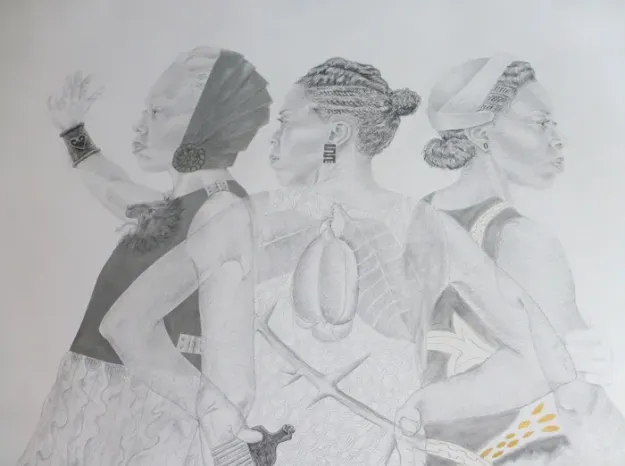
As part of our Black History Month celebrations, Rob Wright, Partner, salutes Charmaine Watkiss, a London based artist who comes from a background in film and design.
Charmaine Watkiss current practice is focussed around drawing and creating life sized figures, exploring African ancestral traditions which have survived the transatlantic; she creates memory stories which shift between the archaeological, the cosmological and the historical spaces – always looking back in order to create a new projection in the present.
She was shortlisted for the Trinity Buoy Wharf Drawing Prize, 2019. This year she was a shortlisted Awardee of the 198 Gallery Women of Colour Award and is currently in a two-person show with Andrew Pierre Hart at Tiwani Contemporary Gallery.
I will admit that until the middle of 2022 I was not aware of her work. But I stepped unplanned into her first solo show The Wisdom Tree in Leeds Art Gallery and her drawings have remained in my mind’s eye ever since.


Technically the show was engaging. Largescale works in pencil, powder, acrylic and ink, accompanied by smaller pieces and sketch books showing her creative processes and thinking. The colours were low-key. The drawings sat on plain white paper.
Themes of justice, equality, diversity and inclusion run through her work. Pieces such as They Didn’t Come to Stay and Facing the Wind deal directly with the experiences of generations of Caribbean women in our country.
At the time of my viewing, I was working in the NHS. Many BAME colleagues had been disproportionately impacted by the COVID crisis when compared to white workers such as myself. And in the wider population social inequality played a big role in how much damage the pandemic inflicted on communities.
Also, the Windrush Scandal was continuing (it still is). Many members of that generation had been wrongly deported from the UK. Jobs and homes had been lost. Legal rights denied. In March 2022 it was concluded that the Home Office had broken pledges to address the culture that had fermented and enabled that scandal to happen.
I think these two factors provided, consciously and subconsciously, a backdrop to my viewing of Watkiss’s work. They intensified my experience of her art and brought even greater poignancy to her messages of hope, courage, identity and resilience.
I want to salute her as a Black female artist not only because, like in so many aspects of life, Black female talent in the art world is often overlooked. But also because she put on paper images that continue to resonate with me today.
I look forward to seeing her work again; a British Museum Touring Exhibition called Drawing Attention will bring her work to my home city later this year. If the show comes your way, pay a visit to celebrate and salute Charmaine Watkiss and her drawings.
Find out more about Charmaine and her works at https://charmainewatkiss.com/.






















